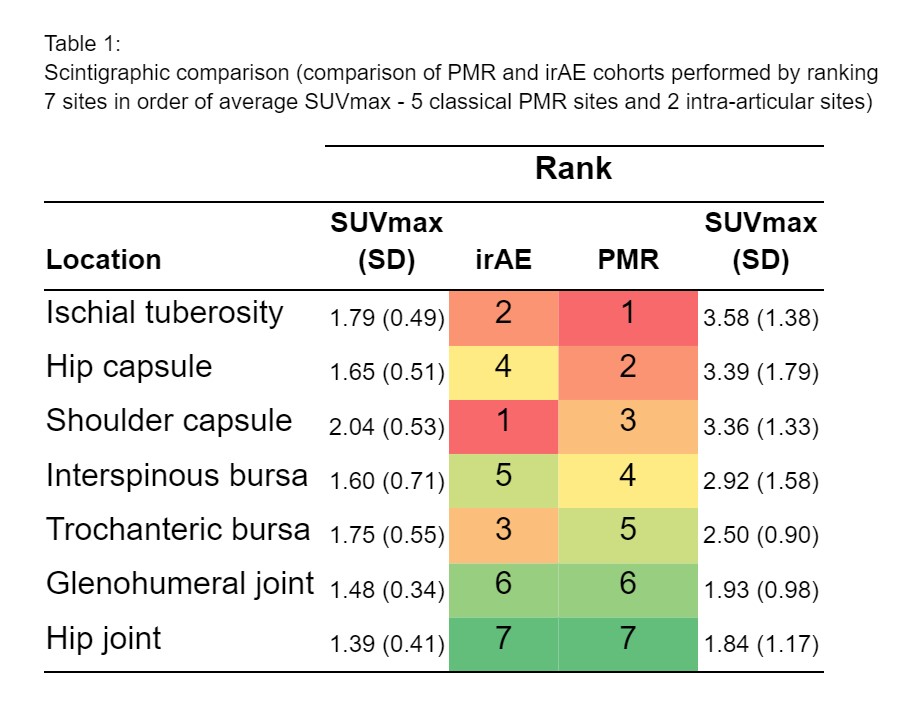Session Information
Date: Monday, November 13, 2023
Title: (1052–1081) Immunological Complications of Medical Therapy Poster
Session Type: Poster Session B
Session Time: 9:00AM-11:00AM
Background/Purpose: Of the rheumatic immune-related adverse events that follow immune checkpoint inhibitor (ICI) cancer immunotherapy, de novo PMR-like episodes without inflammatory arthritis (ICI-PMR) appear to comprise a small subset, distinct from other irAEs. ICI-PMR also appear distinct from classical PMR, given they are temporally related to ICI exposure and occur at far greater incidence than expected for classical PMR alone. ICI-PMR have previously been associated with findings consistent with inflammatory morphological change on [18F]Fluorodeoxyglucose-PET/CT (FDG-PET/CT), a modality used for cancer staging. Classical PMR also has highly accurate diagnostic scintigraphic features on FDG-PET/CT. It is not known to what extent the detailed inflammatory morphological changes in ICI-PMR correlate with those in classical PMR.
Methods: A comparison was made of FDG-PET/CT images from active ICI-PMR and active classical PMR patients. Images in ICI-PMR patients were obtained from a retrospective repository of routine care FDG-PET/CT incidentally obtained for cancer staging. Images were selected where the time of image acquisition correlated with ICI-PMR active disease. Both diagnosis and disease activity assessment for ICI-PMR patients were determined by a rheumatologist expert in irAEs, without reference to FDG-PET/CT. Patients with clinically apparent inflammatory arthritis were excluded. Images in classical PMR were obtained from a prospective research cohort, after diagnosis and prior to glucocorticoid therapy. All patients met the 2012 ACR/EULAR PMR Classification Criteria. Seventeen sites specific to classical PMR FDG-PET/CT assessment were assessed by a nuclear medicine physician expert in assessment of PET/CT for PMR, blinded to clinical context, and were combined into seven regional sites for comparison.
Results: This analysis captured nine patients with ICI-PMR who had an incidental FDG-PET/CT when their ICI-PMR was active. The median age was 79 (69-85). The ICI indication was melanoma in 5 patients, and non-small cell lung cancer in 4 patients. The ICI agent was nivolumab in 4, pembrolizumab in 4, and durvalumab in 1; only one was receiving combination therapy with ipilimumab. There were 31 patients in the classical PMR cohort. While the overall intensity of uptake was lower in the ICI-PMR cohort, notable morphological similarities existed between both sets of patients (Table 1). Of the seven sites, shoulder capsule and ischial tuberosity ranked in the top three for both groups. For both ICI-PMR and classical PMR, intraarticular uptake at shoulder and hip joints was lower than periarticular sites classical for polymyalgia rheumatica.
Conclusion: ICI-PMR and classical PMR demonstrate similar patterns of scintigraphic uptake on FDG-PET/CT. This close similarity in inflammatory morphological change implies that classical PMR properties might inform ICI-PMR research, and that insights from ICI-PMR might prove useful for classical PMR research, as a model of induced disease.
Scintigraphic comparison (comparison of PMR and irAE cohorts performed by ranking
7 sites in order of average SUVmax – 5 classical PMR sites and 2 intra-articular sites)
To cite this abstract in AMA style:
Liew D, Poon A, McMaster C, Buchanan R, Yang V, Scott A, Owen C. Immune Checkpoint Inhibitor Induced Polymyalgia Rheumatica Demonstrates a Similar Scintigraphic Appearance to Classical Polymyalgia Rheumatica on 18F-Fluorodeoxyglucose PET/CT [abstract]. Arthritis Rheumatol. 2023; 75 (suppl 9). https://acrabstracts.org/abstract/immune-checkpoint-inhibitor-induced-polymyalgia-rheumatica-demonstrates-a-similar-scintigraphic-appearance-to-classical-polymyalgia-rheumatica-on-18f-fluorodeoxyglucose-pet-ct/. Accessed .« Back to ACR Convergence 2023
ACR Meeting Abstracts - https://acrabstracts.org/abstract/immune-checkpoint-inhibitor-induced-polymyalgia-rheumatica-demonstrates-a-similar-scintigraphic-appearance-to-classical-polymyalgia-rheumatica-on-18f-fluorodeoxyglucose-pet-ct/

